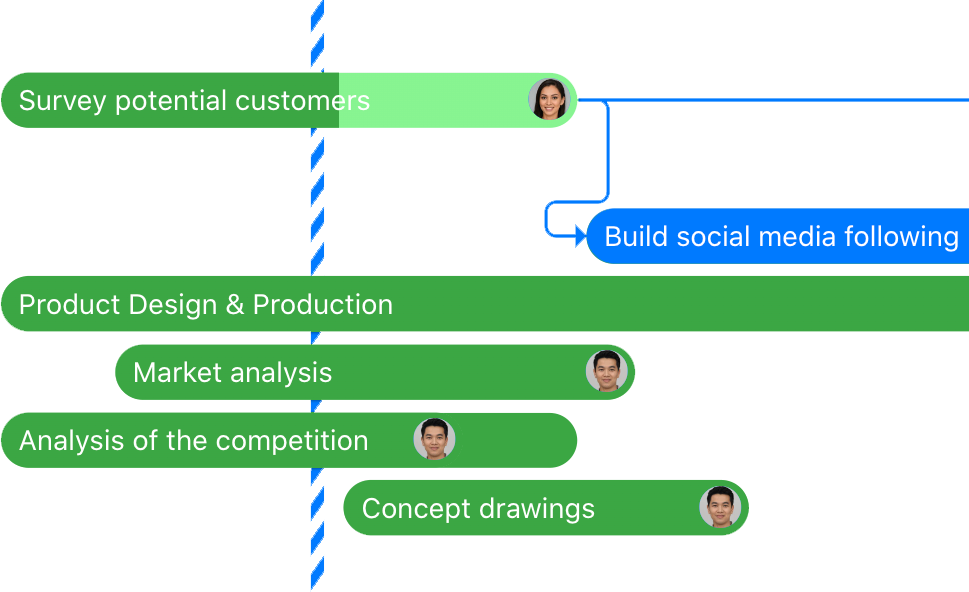
It can be difficult to decide whether to start your next big project with an in-house team or to look for talent elsewhere. There are certainly benefits to both (depending on your project), but for those who have never outsourced a team, there is plenty to be sceptical about.
How do I assemble a specialised remote development team? What should I be on the lookout for? The list of questions can certainly feel endless.
It goes without saying that if you already have a fantastic in-house team, there is no need to outsource a new one. You simply need to select the right team members with the necessary skills to ensure that the project phases are completed on time (often a lot easier said than done!).
When considering whether to outsource or not to grow a business, whether from the ground up or as part of a continuous development process, there are some factors to consider. One major reason for this is that your decision will, of course, have significant consequences (both good and bad – hopefully more good than bad) in the final outcome of your project. As a result, it’s critical to take the time to make the best decision for your company and project.
In this article, we will look at some of the key benefits and drawbacks of having both an in-house and an outsourced team.
Important Questions to Consider Before Choosing a Team
Before we begin, it may be useful to go over some key questions to ask yourself before deciding whether to use an in-house team or outsource to a third party:
- What are your long-term goals?
- What tasks does the company need to accomplish?
- Can outsourcing help the company be better than its competitors?
- How long should each project sprint take?
- What’s the project’s duration?
- Do you have the talent and expertise needed?
- Will the project meet the company’s goals?
What Is In-House Software Development?
In-house software development is the use of the present experts in your company to develop software or partake in a certain project. The company uses the resource team already available to develop the various software. You involve your employees to take full charge of the special project.

In in-sourcing, each team member is assigned a task in the present project. Therefore, the right skilled workers need to be chosen to ensure project success. That’s why it is advisable to have a diverse team who specializes in different things to meet the ultimate goal.
You need to check their level of expertise, work ethics, commitment to work, flexibility, and relevant skills. This will help you choose the right in-house team for the project.
The Benefits of In-House Software Development
Many people underestimate the advantages of having an in-house development team. If you were thinking of outsourcing a development team, these benefits may be able to convince you otherwise.

1. Same Time Zones
An in-house development team means that you will work in the same time zone. Working in different time zones can be a challenge, especially if you’re working with a startup without enough experience in managing the processes.
When working in the same time zone, you can talk directly with the development team. It even becomes easier to make changes in the project. This will reduce any errors and speed up the implementation of the project.
Ultimately, the specific project sprints will be completed at the required intervals.
2. Fast Response Times and Support
In an in-house development team, feedback is given more easily to ensure the timely fixing of bugs. The team will also be working in the same area, so they can consult each other to ensure the project runs smoothly without anyone lagging behind.
In the case that something is discovered while in the process, it will be easier to reach out for third-party opinions before moving forward. It will be easier to observe the work already done and make changes.
3. More Technologies to Choose from
An in-house development team should consist of different talents to ensure faster project delivery. In addition, an in-house team should have different skill sets that fit the evolving digital trends.
Ultimately, the specialized team members will ensure the milestones are met on time. With in-housing, it provides greater control over the project.

Maximize your team's efficiency with our project management software.
Sign up for free today!
The Disadvantages of In-House Software Development

1. High Cost
The project’s running cost can fluctuate at any point and its budget can change everything about how it’s approached. As such, it’s important to remember that in-house development is much more expensive than cooperating with an outsourced third party. While outsourced teams have an upfront bill, the final cost of an in-house team will include rent, taxes, software, hardware, salary, and more. Some additional spending that can easily be overlooked, or even neglected, include staff training, sick days, and employee benefits.
2. Existence of Hidden Costs
Some unexpected costs may come up in the project implementation phase. Therefore, it can become a bit expensive. Additionally, there might be some lack of expertise in a particular area that will require bringing in someone else on board.
3. Lack of Talent
Due to the high demand for software developers, it can be a challenge to find anyone for the role, let alone the ideal candidate. Not only should the project’s developer meet the necessary soft and hard skills required, but they should also fit into the project’s planned budget. With such tough competition from other companies, this can certainly be a tall order.
4. Security Risks
It is difficult to fully control the entire development process and thus give away a sense of insecurity. Also, you can’t be sure when one specialist might leave the team.
You might have invested time in training, and then the specific team member leaves. You will need to start the selection process again to find someone to fit in their shoes.
5. Staff Turnover
While not necessarily something that you would want to have to think about, there is always the risk of your developer moving on to somewhere new. This often happens, as mentioned above, due to the high demand for developers and thus the increased lucrative offers that competitors can offer in order to lure your talent away.
Finding a new developer is a time-consuming process and can negatively affect your project as a result. So, keeping hold of your current developers is definitely a must!
What Is Outsourcing Development?
In outsourcing development, a company hires a third-party team to handle its development projects. In doing so, you’re outsourcing to individuals with unique expertise to handle a certain project in your company.

As a result, the development team will concentrate solely on your project. This usually helps to ensure that the project finishes on time (due to fewer distractions) and that the final product is of a certain quality.
Teams can be outsourced in a variety of areas, including but not limited to UX design, consulting, software architecture, and software testing.
The Benefits of Outsourcing Software Development

Outsourcing has some advantages that make it more viable. However, it depends on the project to be undertaken. One understated advantage is the diversity you get.
1. Expertise
It is a cost-effective hiring model, especially for startups in high-income countries. You can save on hiring expenses as compared to when hiring a permanent employee for the project. Unfortunately, onboarding new hires is a process.
On the other hand, it is easy to get a remote dedicated development team for hire. When outsourcing a development team, you can get high-quality talent without compromising on expertise cost-effectively.
2. Large Pool of Talent
Outsourcing reduces the pain points of hiring staff to scale your team. With outsourcing, there is no limitation when searching for talent. You can develop a team from anywhere around the globe.
An outsourced development team can have some great talent and expertise due to working with multiple clients on different projects. You will also need to know how to retain the talent to ensure you can count on them when need be.
3. Lower Costs
As already highlighted in the disadvantages of using an in-house team, the cost of outsourcing will be undoubtedly lower. While cost is not necessarily the primary motivator for most organisations to consider outsourcing software development anymore, cost savings are undoubtedly expected. This is due to the fact that the “total” cost of outsourcing will be predetermined, making budgeting easier and reducing the risk of unexpected expenditures.
4. The Ability to Choose Your Technology and Working Conditions
With an outsourced development team, you get a chance to improve or even completely change your project, product, and workflow. They might have knowledge of a photo editing tool that was not known to your business.
Ideally, you can check the project’s progress and collaborate with the whole team to know what is currently working and what is not. You also reduce the burden of too much workload on your in-house team.
5. Time Savings
Finding and interviewing candidates, negotiating compensation, and onboarding a new employee all take time, and some employees leave for a better opportunity a year or two later. Working with an outsourcing partner allows you to delegate a large portion of the recruitment process, freeing up time and energy for tech leaders to focus on higher-value initiatives for the company.
The Disadvantages of Outsourcing Software Development

1. Time Zone Differences
Time zone differences hinder communication. There may be issues with language, culture, or time zones themselves. If you are in different time zones, it can lead to slower problem-solving processes.
Outsourcing can quickly run into problems if there is a cultural misalignment with the partner company and/or the development team has poor English skills. Time-zone differences where there is limited workday overlap can also lead to a breakdown in communication when expectations are not appropriately set. In-house project managers who are responsible for an outsourced team can help with that, and well-aligned partners are used to managing the challenges of working across time zones.
It’s very important to incorporate the use of a communication tool such as a web conferencing platform. However, it’s even more important to use it to set up regular meetings and check-ins to ensure that you and your outsourced development team are constantly on the same page from project start to finish.
2. Cultural Differences
Cultural differences can hinder the expected workflow. While it’s easy to point fingers toward language as being the only major barrier here, it would be foolish to assume that this is the only aspect needing to be taken into consideration. Culture can affect how people interact with one another, what they consider to be an adequate means of communication (or amount), as well as what is considered a “normal” working culture.
There’s too much to unravel here about the influence of culture in the workplace, however, what is important is that these cultural differences are recognised and, most importantly, respected. When outsourcing, you must recognise cultural differences, select the right tools and methodology, reduce assumptions, establish consistent communication, and test collaboration.
3. Quality
When outsourcing, you only have the word of third parties that their level of quality is as good (or better) than what you’re expecting. As such, it’s easy to fall into the “bait and switch” trap in which third parties pitch you their “A-Team” yet transfer the project later down the project’s lifecycle to less experienced developers.
4. Company Morale
The vast majority of the time, outsourcing is used to supplement internal headcount rather than replace it. However, some employees may perceive outsourcing as a threat to their role within the organisation, which can lead to decreased productivity and a reluctance to integrate an outsourced partner into the team. Clear communication from leadership and management is critical in outlining the role of outsourcing and how it will affect individual team members.
Going Hybrid
It’s important to remember that depending on the project’s requirements, a hybrid approach that combines both internal and outsourced teams is also an option. Another approach is for the company to manage product and strategy while outsourcing all technology tasks to an outsourcer.

If you decide to use a hybrid system, it is critical that you have a reliable means of communication not only between yourself and all parties involved but also between your in-house and out-of-house teams. Going to the trouble of finding the right out-of-house team for your project is counterproductive if your project is subsequently hampered by poor management.
A hybrid system also necessitates an understanding of which team will handle which tasks. Will it be an even 50:50 split, or will you push more work onto one team over the other? When making your decision, make sure that the respective team has the capacity to take on the amount of work you assign to them. While this may seem obvious, it is frequently a major area that is overlooked or forgotten when organising such a system.
Final Thoughts: Choosing the Best Development Team
The right choice depends on the long-term goals of your business. If it is a quick fix, outsourcing is the obvious choice. However, if the problem requires long-term effort, you may need to think about investing in employee training, skill advancement, and infrastructure.
If your in-house team has the required training, it will be easier for them to collaborate and even implement the project. However, as a start-up, you need to invest in high talent, to ensure your business starts up on a high note.
If you aren’t sure how to acquire a development team, you can consult a reliable recruiting agency to help make the process easier. You will just need to approach the agency, give your specifications and interview the different candidates. Choose the best development team effortlessly!
About the Author: Erika Rykun is a career and productivity copywriter who believes in the power of networking. In her free time, she enjoys reading books and playing with her cat, Cola.





Leave a Reply